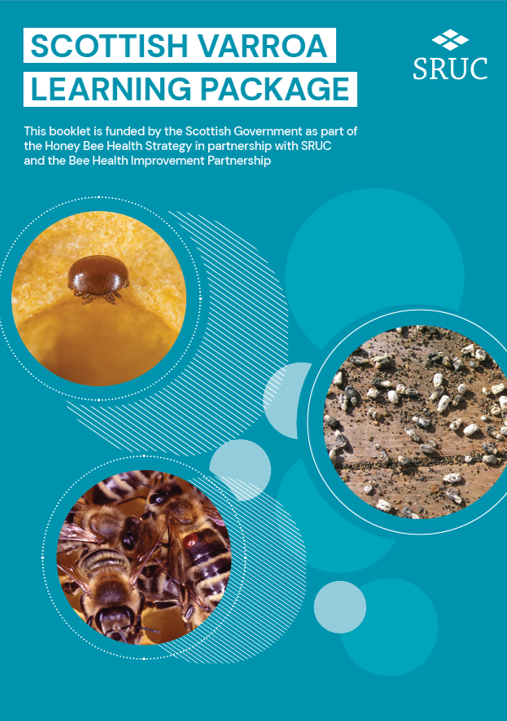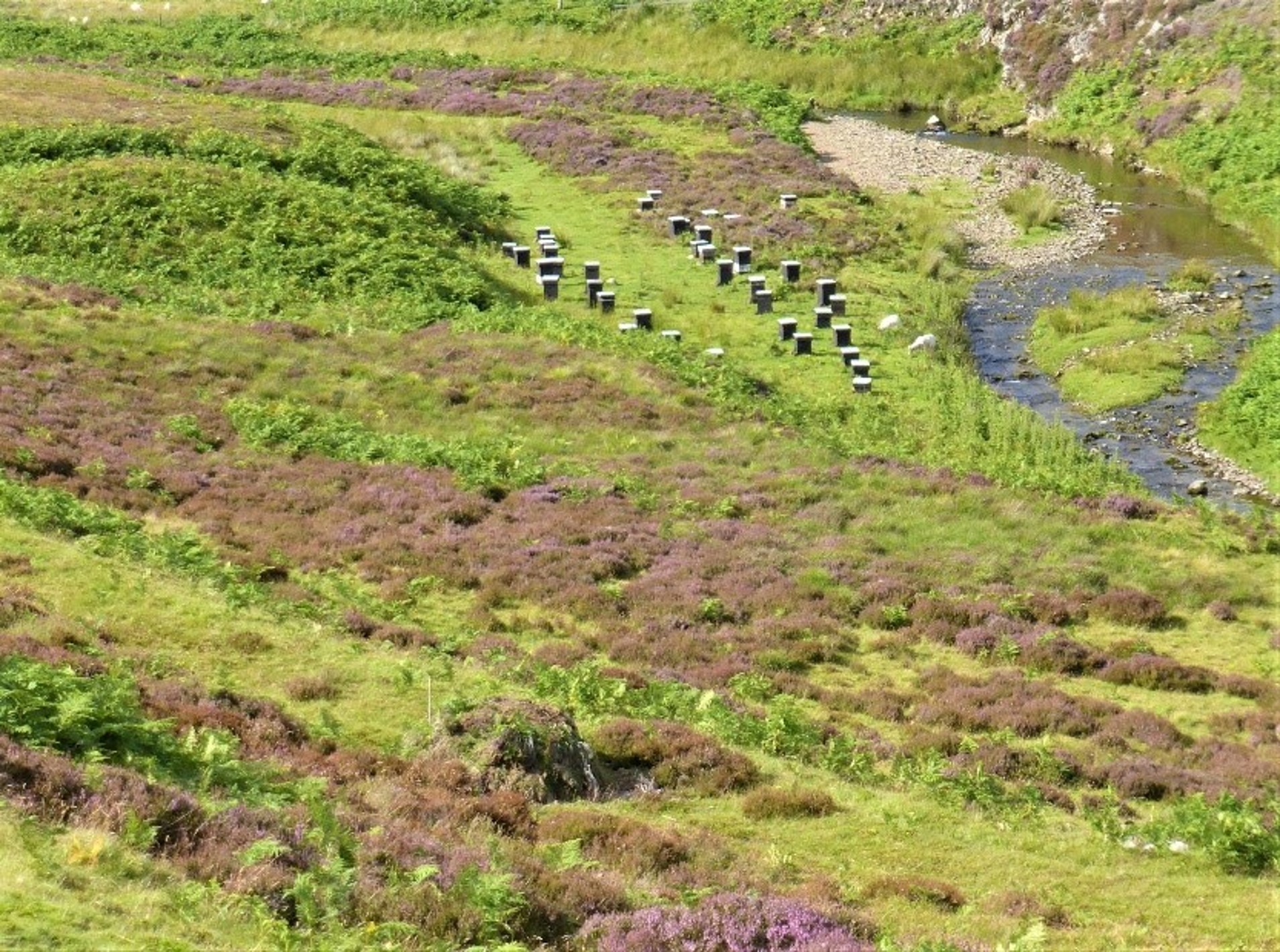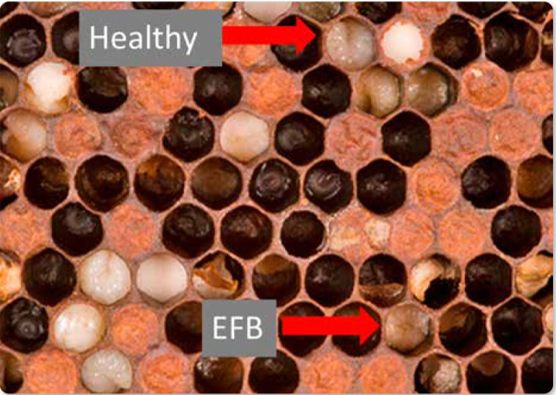Honey and other Hive Products
Honey
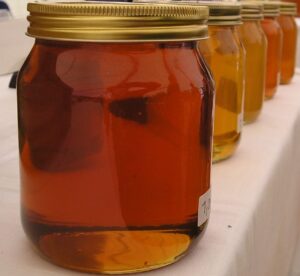
What is Honey
- A subtle blend of sugars – mainly the simple sugars, fructose & glucose but also maltose & others, over 15 organic acids (malic, butyric, acetic etc), about 17 amino acids (proline, glutamic, lysin. etc), up to 7 proteins, approx 12 elements (potassium, calcium, sulphur etc). Made by the bees from nectar (mainly the complex sugar Sucrose) or from the sugary liquid harvested by the bees from plant sucking insects such as aphids.
- Fructose and Glucose (C6H12O6 )
Glucose and fructose have the same chemical formulae, i.e. the same constituent elements and the same amount of these elements per molecule. However, because the chemical links are arranged in a different form within the molecule, the two sugars have different properties Specifically: Glucose is much less soluble i.e. it comes out of solution (crystallises) much more readily than fructose. Honeys high in Glucose (such as honey from clover or Canola (Modified Oil Seed Rape)) thus tend to crystallise quickly. This in no way detracts from the quality of the honey.
- Honeydew honey – made by the bees from sugary liquid harvested by bees from plant sucking insects. As well as the simple sugars, also contains trisacharide sugars (e.g. melezitose, erlose, raffinose).
How do the Bees make Honey
Conversion of Nectar into Honey involves two changes
- A chemical change – disaccharide sugar (sucrose) is “inverted” into monosaccharide’s (fructose & glucose). The bees add the enzyme invertase to effect this change.
- A physical change (evaporation of water) reduction from say 60% water to under 20%. Lots of space is needed to “hang the honey out to dry” so an excess of supers should be fitted in strong flows (“over-supering”) and sufficient hive ventilation (wide entrances in strong flows). The walls of the cells are coated with a thin layer of honey and the bees waft air through the hive to aid drying.
What is the Chemical Composition of Honey & Limits for Honey for Sale (Typical)
Density 1.4 kg/litre
Water 17-19% (max allowable 20% (23% for Ling heather))
Fructose 38-40%
Glucose 31-35%
Sucrose 1-3%
Other sugars 8%
Acids 0.5%
Ash (minerals) 0.1-0.3%
Nitrogen 0.05%
Acidity pH 4
Legal requirements for Honey which is to be sold.
Maximum water content 20% (23% for Ling heather honey)
Diastase enzyme –Min. required is 8 Schade units; 1 Schade unit = enzyme needed to convert 0.01g starch in 1 hr at 40C. Diastase is destroyed with temperature, having a Half-life at 20C of 4yrs, but at 70C only 4hrs
HMF (Hydroxymethylfurfuraldehyde) produced when sugars are heated. Max. permitted = 40mg/kg
Uses of Honey
Table Use
The public tend to expect their honey to be liquid and honey coloured. This has tended to lead to supermarket honey being heated and super-filtered to discourage crystallisation. Crystallisation can commence by crystals growing on solid particles within the honey such as pollen grains.
However, set honey and soft-set (Canola) honey is now quite popular.
Medical uses
Because honey has a high sugar content, it tends to attack bacteria by dehydrating (sucking the water out) them.
It also contains hydrogen peroxide (produced by the action of the enzyme glucose-oxidase on glucose), which is an effective bactericide.
It is especially effective in treating burns and ulcer wounds as it keeps the wound moist and bacteria free until the fine skin forms and prevents this layer being ripped off when the bandage is removed.
Sources of Nectar
Bees use many plants to produce honey, especially hardwood trees such as Sycamore, Fruit Trees, Lime and bushes such as Flowering Currant, Brambles and many others (see garden plants for bees elsewhere on this site)
In addition, certain agricultural crops have traditionally provided large quantities of honey.
These are:
Clover (Trifolium repens) – Wild white clover is best as honeybees with their shortish tongues can easily reach the nectaries in the shallow flowers. The higher yielding red clover has deeper flowers and are difficult for honeybees (second cut crops are better as the flowers are shallower). Clover ceased to be a major honey crop with the advent
of silage – the clover was cut before it flowered.
Field beans (Vicia faba)– limited to the south east of Scotland
Modified Oil Seed Rape (OSR 00 or Canola)(Brassica napus) – This took over from clover as the major honey crop in the East of Scotland.
There are other specialist plants now being grown in Scotland such as Phacelia (Phacelia tanacetifolia) and Borage (Borago officinalis), but these are as yet not significant for national honey production.
The moors of Scotland produce large quantities of nectar from Ling heather (Calluna vulgaris) and it is the honey for which Scotland is perhaps best known and commands a premium price. Ling heather honey is higher in protein than other honeys which makes it thixotropic (jellyish) and difficult to extract. It is thus often sold as comb honey. The moors also produce Bell heather (Erica cinerea) honey which can be processed by normal extraction to produce a beautiful port wine coloured honey.
Although honey is considered a very safe foodstuff, it is possible that it may become contaminated with Clostridium botulinium bacteria due to careless placement of supers on the ground (always place supers on an upturned roof). For this reason it is advisable to label honey “Not to be consumed by children under 1 year old” as their gut system may not be robust enough to deal with Botulinum toxins. See Technical Data sheet 16 on this website.
See the video clips in the Bee Basics section of the website for the extraction process for honey.
Beeswax
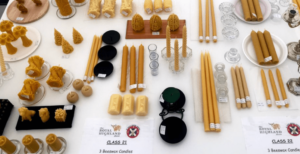
Wax is normally obtained from the cappings which are removed from the honey comb prior to extraction and has many uses such as:
Making candles, making wax foundation, making decorative wax mouldings, encaustic art, use in leather working, use in cosmetics, wax wraps.
Beeswax – where does it come from?
- From the glands of the worker honeybee – usually most productive at 2 to 3 weeks of age
- They have 4 pairs of wax glands in the underside of their abdomen – the wax oozes out as a liquid hydrocarbon onto a smooth area (the wax mirrors) of the exoskeleton and dries to a wax scale which the bees can pick off using their feet, before transferring to the mouth for further working. There are approx. 1 million wax scales per kg of wax.
- Drones and Queens do not have wax glands.
Some facts
- Melting point of beeswax 62 to 64 Celsius
- Flash point of Beeswax approx. 240 Celsius
- Discolouring temperature of beeswax 85 Celsius
- Density of beeswax 0.95 g/cc (note liquid wax is approx. 10% less dense as it shrinks on solidifying)
- The bees use about 6 to 7 kg of honey to produce 1 kg of wax
- There are 300 components in beeswax
- 50,000 bees should be able to produce about 230 g of wax in a day.
- On average 1,8 million wax scales are required to make 1 kg of beeswax
Preparation of wax
Safety – Processing wax involves high temperatures of both wax and water and hot wax sticks to skin causing serious burns. Use safety glasses and closed shoes (no sandals)
Wax should never be directly heated but should always be indirectly heated in a container sitting in a water bath or in a Bain-Marie.
Select for quality – good colour and cleanliness
Wash cappings in rainwater (or soft water) -the lime in hard water spoils wax
Preliminary cleaning for a small quantity of wax:
- Place a Pyrex (heatproof borosilicate glass) jug (number 1) in a pan of simmering water hot enough to melt the wax.
- Place wax in jug to melt – use capping wax which is purest. Wax from combs will be contaminated with propolis. Place a crumpet ring or some such to prevent jug from contacting base of pan.
- Sit a metal kitchen sieve/strainer lined with a nappy liner or if unobtainable, a layer of J cloth and dried baby wipe (e.g.Pampers fragrance free) in a second Pyrex jug (number 2) and place in a warm oven.
- Sit the jug on an old baking tray to save wax spillage on the oven floor. This warms the filter so that the wax does not solidify when it is poured into the filter.
- Remove from oven pour liquid from 1st Pyrex jug into filter in 2nd jug.
- This thoroughly cleans the wax which is now suitable for using except for show exhibits.
Show candles:
- Wax will require a further clean.
- The 2nd Pyrex jug can have 2 strainers, one smaller than the other, i.e. the first filter is as above and the second is lined with flannelette fabric in the warm oven.
- Pour filtered wax from jug no. 1 above into the warmed filters of jug no 2.
- The wax is now suitable for pouring straight into the candle mould(s) or into a prepared container
Cake of Wax for Show Entry
- Check Show schedule for size of container, minimum weight and thickness of cake.
- Pyrex bowls usually have a good surface finish but check that the bowl or dish does not have the imprint Pyrex on the inside. Check that the dish will produce a cake of the correct dimension and weight and mark on the outer surface, how far up the dish the wax will have to come to achieve the requirements. (remember liquid wax shrinks 10% on solidifying so allow for this when making the mark). Weight can be checked by pouring a measure of water into the dish (wax density is 0.95 x that of water so a volume containing 478 cc of water will contain 454 g (1 lb) of wax.- add 50cc for tolerance)
- Rub a very small amount of dish washing liquid around the inside of the dish, using a non fluffy cloth – don’t touch the surface by hand thereafter.
- Place the dish and a glass or metal place mat covering the dish in a warm oven and leave until all is at an even temperature. To help slow cooling (to avoid cracking of the wax moulding), the mould can be left in a basin of hot water or in the oven (a pre-heated brick will allow the oven to cool more slowly)
- Pour double filtered wax into warmed moulding dish making sure it reaches the desired level.
- Leave in the oven covered by a glass or metal cover. Switch off oven after a few minutes and DO NOT open oven for several hours. E.g. prepare in evening and open oven next morning.
- Pour a small amount of cold water into dish and wax should float. Leave in fridge if it does not float immediately. It may take several days to float. Be Patient
- Note – When pouring melted wax into moulds avoid using the last dregs as it may have some debris.
Wicks
When making candles, always ensure that the wick is central in the mould. Always dip the wick in liquid wax as this helps to remove air from the wick and helps the candle to light. Essential for show candles.
Sizing:
If the wick is too thick, molten wax is drawn up too quickly resulting in a large, flickering, smoky flame.
If too thin a large pool of wax develops and runs down the side of the candle – guttering.
Bees wax candles require a wick twice as thick as paraffin wax candles.
Wick is usually sized in numbers related to the diameter of the candle e.g. Size 0 for 6 mm candles, size 1 for 12 mm, size 1A for 20 mm, size 2 for 25 mm, size 3 for 30mm etc. Ask the supplier for advice on sizes.
Moulds:
Silicon moulds are superior to rubber moulds and easier for cast removal.
Take care when removing mouldings to ensure that you do not split the mould.
Summary:
Use the best wax you have. Capping wax, especially from heather honey is the best. Make sure the wax is thoroughly clean as even minute quantities of propolis will cause the candle to spit (the show judge will light your candle). Dirt will show as the candle burns and liquifies a pool of wax.
Candle making can be messy. Work in a warm room.
Pollen
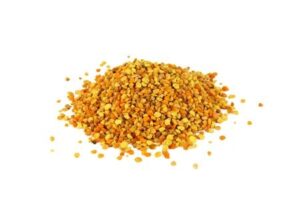
Although not sold in large quantities as a pure product in Scotland, there is always a small amount of pollen in honey. Pollen grains are very small (typically 25 micron but varying from 6 to 150) and so can easily pass through the typical honey straining clothes of 200 to 300 micron.
Pollen is the male part of the flower and is harvested by the bees for its high protein content. It is brought back to the hive in the workers pollen baskets on their hind legs. It is then used or stored in honeycomb cells sealed up with a smear of honey. Being a proteinaceous substance, it does not store very well, and the bees are always desperate to harvest fresh pollen when brood rearing commences in early Spring.
Various claims are made for pollen such as helping with hay fever. However, the lack of specific controlled (double-blind) testing prevents us from making such claims when selling the product.
Pollen can be harvested by temporarily fitting a pollen trap to the entrance of the hive. These traps knock the pollen off the workers pollen baskets as they enter the hive down into a collection tray. However, these traps can only be left on the hive for two or three days since they could deprive the bees of pollen with which to feed their larvae.
Pollen can also be stored in a freezer over winter and used to make pollen patties, a mixture of pollen and sugar which can be fed to the bees in early spring when flowers are scarce. However, it has to be said that the bees far prefer it to be fresh.
See also Pollen substitute on Tech Data sheet 9 of this website.
Propolis
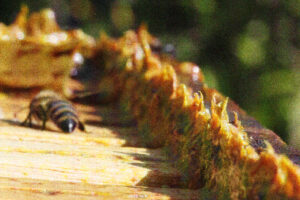
Propolis is a sticky material gathered by the bees from the buds of trees (mainly Poplar), brought back to the hive in their pollen baskets, unloaded (with difficulty and usually requiring the help of a sister) and used for various purposes, both constructional and disease/health related.
It is a substance with good anti-virus, bactericidal and fungicidal properties.
The bees use it to seal cracks in the hive, to varnish interior areas of the hive and to varnish the inside of cells prior to the queen laying in them. The bees sometimes also build walls of the material across the entrance to reduce the size of the opening to aid defence from wasps and other robbers. The word is derived from this use – Propolis=Before the gate.
Some bees harvest and use large quantities of propolis which makes the beekeepers task rather sticky. One of the few substances that will remove propolis from clothing and tools is washing soda at a concentration of 200g of powder per litre of water. This is also an excellent solution for the hygienic control of pathogens in beekeeping.
Propolis is used in various applications such as in toothpaste, and throat treatments because of its bactericidal properties. However, there is a lack of control testing of the product and indeed such testing is very difficult because of the varying chemical content of the substance depending on the plant source, so it has failed to become establish as an approved apitherapy medicinal product.
Sting Venom
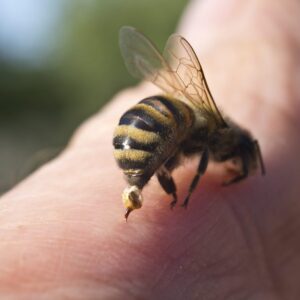
Bee venom is produced by the female worker bee and contains many active components including peptides such as melittin, apamin, mast cell degranulating (MCD) peptide and adolapin, along with enzymes such as phospholipase, and hyaluronidase, also some amino acids and other volatile compounds.
Sting venom is only used in specialised medical treatments such as the desensitisation of people who have become critically allergic to bee stings. Relatively few medical centres offer this treatment, and it must be carried out under ultra-strict medical supervision.
Claims have been made for venom in the treatment of arthritis in animals and humans, but there are again no controlled tests which back up the claim for its effectiveness and these folk-treatments must be treated with great caution.
Stings are potentially very dangerous in the head or neck areas and protective clothing must be worn at all times when opening hives and handling bees and a watchful eye must be kept for signs of a serious allergic reaction such as anaphylaxis.


